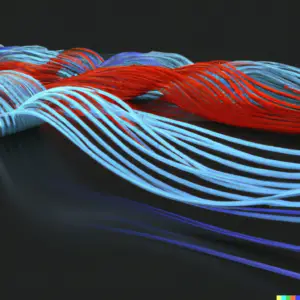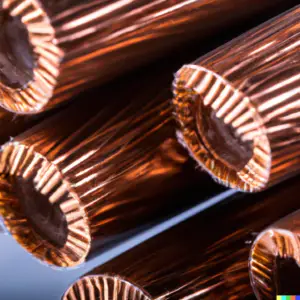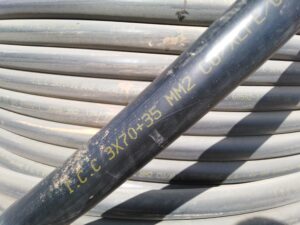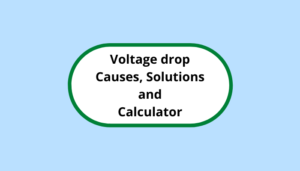Coiling electrical cables is a routine task for anyone working with electrical equipment.
However, not many people are aware of the risks and hazards involved in coiling energized cables. Coiling energized cables can cause electric shock, fire hazards, and equipment damage.
Therefore, it is crucial to understand the proper coiling techniques for both energized and non-energized cables.
Coiling cables are an essential part of cable management in electrical equipment. It helps to organize cables and reduce the risk of entanglement. However, coiling energized cables requires special attention and care to ensure safety.
Table of Contents
II. Coiling Energized Electrical Cables
True Story: The Dangers of Neglecting Cable Coiling Techniques
A few months ago, while working at my job, a coiled electrical cable was used to energize an oil filtering machine for a transformer.
Unfortunately, things quickly took a dangerous turn. The wire became hot to the touch, and before we knew it, the insulation started to melt away. It was a shocking sight to see, and we knew we had to act fast to prevent a potential disaster.
Thankfully, the circuit breaker tripped, and the power was cut off before any further damage was done. We were lucky that day, but it could have easily turned into a tragedy if we hadn’t taken immediate action.
This experience taught us the importance of handling electrical equipment with care and following best practices for safety.
Using coiled cables to energize machinery is a risky practice that should be avoided at all costs.
It’s crucial to always prioritize safety and be aware of potential hazards when working with electrical equipment.
By taking these necessary precautions, we can avoid accidents like this and ensure a safe and healthy work environment for everyone involved.
A. Risks and Hazards
Coiling energized cables is dangerous and can result in electric shock, fire hazards, and equipment damage.
Electric shock can occur if you accidentally touch a live wire while coiling an energized cable. Additionally, if the cable is not coiled correctly, it can create a fire hazard by overheating.
Furthermore, coiling energized cables improperly can lead to equipment damage, which can be costly and time-consuming to repair.
Besides, energizing coiled electrical cables can create a magnetic field that generates heat, which can cause the cable to overheat and become a fire hazard.
This is particularly true when coiling high voltage cables, where the magnetic field generated can be quite strong.
The heat generated by the magnetic field can also lead to the insulation on the cable melting or degrading, which can increase the risk of electric shock.
It’s crucial to handle energized cables with care and follow best practices for safety to prevent these risks and hazards. Thank you for bringing this important point to my attention.
B. Techniques for Coiling Energized Electrical Cables

To avoid the risks and hazards associated with coiling energized cables, you should follow these best practices for safety:
- Always wear appropriate personal protective equipment (PPE) such as rubber gloves, safety glasses, and rubber-soled shoes.
- Use insulated tools when handling energized cables.
- Use a cable reel or a spool to wind up the cable.
- Use a cable sock to protect the cable from abrasions and damage.
- Keep the coiled cable away from other electrical equipment and heat sources.
- Label the coiled cable with the appropriate voltage rating, so others are aware of the risks.
III. Coiling Non-Energized Electrical Cables
A. Benefits of Proper Coiling Techniques
Coiling non-energized cables using the proper techniques can help to extend the lifespan of the cable, reduce the risk of damage, and improve cable management.
Properly coiling non-energized cables can prevent the cable from becoming entangled or damaged, leading to a longer lifespan.
Read also my comprehensive article: Bending Electric Wires: Know the Risks
B. Techniques for Coiling Non-Energized Electrical Cables
To properly coil non-energized cables, follow these best practices for efficiency:
- Lay the cable on a flat surface.
- Straighten any kinks or bends in the cable.
- Use your dominant hand to grasp the cable and your non-dominant hand to guide the cable.
- Use the over-under technique to coil the cable. This technique involves coiling the cable over and under your hand in a figure-eight pattern.
- Use a cable tie or velcro strap to secure the coiled cable.
IV. Comparison between Coiling Energized and Non-Energized Electrical Cables
A. Differences in Risks and Hazards
The primary difference between coiling energized and non-energized cables is the risks and hazards involved.
Coiling energized cables requires more precautions and PPE to prevent electric shock and fire hazards while coiling non-energized cables is a straightforward process with minimal risks.
When electrical cables are coiled while energized, the magnetic field generated can cause the cable to generate heat, leading to damage to the cable’s insulation and increasing the risk of a potential fire hazard.
B. Differences in Techniques
The techniques used to coil energized and non-energized cables differ. Coiling energized cables requires additional precautions, such as using insulated tools, wearing PPE, and using a cable sock to prevent abrasions.
Coiling non-energized cables is a simple process that involves straightening the cable and using the over-under technique.
V. Conclusion
In conclusion, proper cable coiling techniques are crucial for safety, efficiency, and equipment lifespan.
Coiling energized cables requires special attention and care to avoid electric shock, fire hazards, and equipment damage.
By following best practices for safety, such as wearing PPE and using insulated tools, you can reduce the risks associated with coiling energized cables.
Coiling non-energized cables using the over-under technique can improve cable management, extend the lifespan of the cable, and reduce the risk of damage.
By understanding the differences in risks and techniques between coiling energized and non-energized cables, you can take the necessary precautions to ensure your safety and the safety of those around you. Remember, always prioritize safety when working with electrical equipment.
Don’t Leave Empty-Handed!
Install my Free Android App on Google Play:
Electrical Cables Most Common Tables “Cables Tables”
And, my Electrical Calculations App “Fast Electrical Calculator”
Discover more great content by subscribing to My channel
Looking to stay ahead of the game in the world of electrical engineering? Subscribe to my YouTube channel and gain access to exclusive content you won’t find anywhere else!
The staff I recommend
(Amazon Affiliate Links to products I believe are high quality):
- Economy 120 Volt/60Hz AC Power Source – Step-Down Voltage & Frequency Converters 1800W
- UNI-T Digital Multimeter Tester UT139C
- 50-Amp Extension Cord for RV “100ft”
- Voltage Stabilizer 110/220v
- Hair Dryer “best selling“
- TOSHIBA EM131A5C-BS Countertop Microwave Ovens
Disclaimer: This contains affiliate links to Amazon products. I may earn a commission for purchases made through these links.



